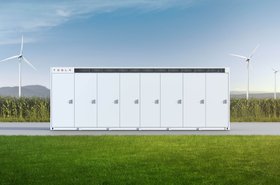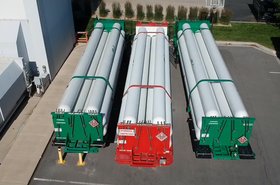Data center operators have been mindful of their power consumption for some time. Just how mindful is open for debate - and very hard to ascertain since many countries don’t break out statistics for data center power consumption.
Some estimates suggest data centers account for as much as three percent of the worldwide electricity consumption, but the most authoritative study, done in 2010 by Stanford University professor Jonathan Koomey, put the worldwide draw at between 1.1 percent to 1.5 percent. Koomey and his colleagues have updated this since and found that the growth in energy demand is mitigated by increases in efficiency.
Whether they adopt hydro wind or solar power, data center operators are striving to be as green as possible. However, one thing is for certain, data center operators want to get off fossil fuel as quickly as possible, but out back behind every data center is a diesel generator - normally a set of them - just in case.
These diesel generators are there to deliver energy for short periods when there is a power outage. That sounds like a job that could be done by batteries, but that is not going to happen overnight, according to Adam Kramer, executive vice president of strategy at US-based provider Switch: “Do we think eventually we will be able to use battery storage to replace that? Maybe. But our number one job is to make sure our clients are up 100 percent of the time.”
The same goes for Equinix, the largest data center provider worldwide, according to Craig Pennington, vice president of global design.
“I'm hoping that we can prove over the space of a few years that the only time those diesel generators ever run is to just do the monthly performance test to make sure that they're there if we ever need them,” said Pennington. “I'm hoping that we can get to the point where we feel confident that we can build a facility without diesel.”
This article appeared in Issue 39 of the DCD>Magazine. Subscribe for free today
Diesel lives… for now
Jennifer Cooke, research director for data center issues with IDC, doesn't see the transition away from diesel happening quickly. “Like anything in the data center space, obviously, it's mission critical. Changes will happen slowly, because it's more important to run the business,” she said.
Having said that, customers are demanding change from operators, she said: “I do hear of more data center builders saying that their customers who are engaging with them to build data centers are increasingly asking, ‘Can we do this without a generator?’ A lot of that is coming from their desire to become a ‘cleaner’ company, a greener company.”
At this point, customers are asking and operators are in the investigative stage. Most operators are not actively shunning diesel generators yet. “I think that it will happen, maybe to some extent in shrinking, but probably not within the next ten years,” said Cooke. One of the few exceptions is Google's battery project in Belgium, which we explore on page 44.
The UPS also lives on
Switch also made news last July when it announced a partnership with First Solar and Tesla to store solar power in Tesla Megapacks. Switch has been running its Nevada data centers on 100 percent solar power since 2016 but couldn’t store energy gathered during daylight hours because the technology to store mass amounts of electricity wasn’t ready.
Tesla’s Megapack is a beefed-up version of the Tesla PowerWall used in residences to store solar power for just a house. Each Megapack can hold up to three megawatt hours (MWhs) of power and 1.5MW of inverter capacity.
Those Megapacks don’t do the whole job though - Switch’s uninterruptable power supply is hanging on for practical reasons, said Kramer: “We use lithium-ion Megapacks outside the data center, and the UPS is a lead-acid battery inside the data center. The switching technology we deploy on our UPS batteries to provide dual conversion of the energy is better suited on a data system to maintain the resiliency inside the data center. They serve distinctly different purposes.”
But Tim Hughes, director of strategy and development at data center provider Stack, views the batteries as an opportunity to extend UPS systems rather than replace them. “I have looked at the idea of essentially just expanding the size of your UPS battery. I think you could view batteries as a potential functional augmentation of UPS versus a replacement of UPS,” he said.
Next steps in battery power
Battery technology chemists continue to make impressive strides in lithium-ion technology. In October 2020, the US Energy Information Administration (EIA) issued a report that showed grid-scale battery-project costs in the United States dropped 70 percent in just the last five years. Between 2015 and 2018, average project costs decreased from $2,152 per kilowatt-hour of storage to $625.
But while a good advance, it still falls short of data center needs, said Hughes. “What they're solving is on a daily need level, but what happens when I need it for a week? We've seen events happen that are not common but do happen, in which we had data centers running on backup generators for days on end, that would have created pretty significant issues, because you wouldn't have enough power,” he said.
And last year, the Uptime Institute noted that lithium-ion is still unproven in data center scenarios as compared to vented lead-acid (VLA) or valve-regulated lead-acid (VRLA) batteries, particularly as relates to failure mode. So there are a variety of efforts taking place in battery technology beyond just improving Li-ion technology.
One of them is an Australian startup called Lavo Hydrogen Technology Ltd., which uses power from rooftop solar panels to produce hydrogen from water by electrolysis. The gas is stored in a metal hydride container and converted back into electricity when needed using a fuel cell. Lavo claims its energy unit will be able to hold 40kW hours of energy, compared to 13.5kWh in Tesla’s Powerwall.
Tesla did not return requests for comment, nor did competitors Bloom Energy or Lavo.
Another battery technology hitting the market is nickel-zinc (NiZn), promoted by a startup called ZincFive. ZincFive claims its NiZn Battery Energy Storage Solution product has backward and forward compatibility with megawatt class UPS inverters with rapid charge/discharge capabilities across a wide temperature range without the threat of thermal runaway.
NiZn batteries promise a greater than 10-year operating life with minimal maintenance requirements, contributing to a low TCO relative to short-lived lead-acid batteries with high annual maintenance costs. They also check the sustainability box with non-toxic, widely available materials that are easily recycled.
The space problem
While battery technology continues to advance, it is only part of the problem of powering data centers, especially hyperscale data centers, which are the size of football stadiums.
The biggest issue, argues Pennington, is having access to adequate solar power for these large systems, but energy density for solar is relatively low. “To power a data center you need acres of space, at least four acres of land to generate a megawatt or store hundreds of megawatt hours,” said Kramer.
Switch’s Reno solar farm is expected to generate around 550MW. By way of comparison, the Topaz Solar Farm in San Luis Obispo County, California, offers 550MW and covers 4,500 acres with solar panels. That comes out to 8.2 acres per MW. Ideal for the Nevada desert, perhaps, but a non-starter for data centers in large cities.
“It's not like you could do that in downtown Frankfurt,” said Pennington. “Even if you cover the entire roof of your data center with solar with solar power with solar cells, you're not going to generate enough power to power the whole facility.”
The Edge opportunity
While solar might be a tough ask in the city, battery power could be good for the urban Edge, where data centers are much smaller and don’t need as much power, said Cooke: “If you think of Edge data centers, they're not going to be in a place where a lot of times people want something so noisy and smelly as a diesel generator, so I think we'll see a lot more different battery technologies and different backup power sources, as it shifts to more distributed locations, where it's just not feasible or allowable to have generators.”
She continued: “I think local regulations on noise and pollution will prohibit diesel generators in many places. If it's very disruptive, like in a hospital or retail location, things that are quieter, less obtrusive, will be the preferred solutions.”
Like with so many data center technologies, change will come slowly in the risk-averse data center industry. The technology will improve but another driver is pushing the industry as well: the sustainability pledges providers are making.
It seems the change will be forced as much as embraced.






